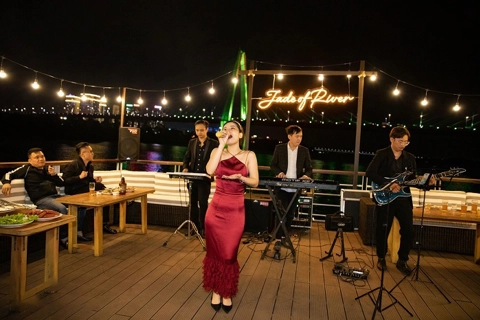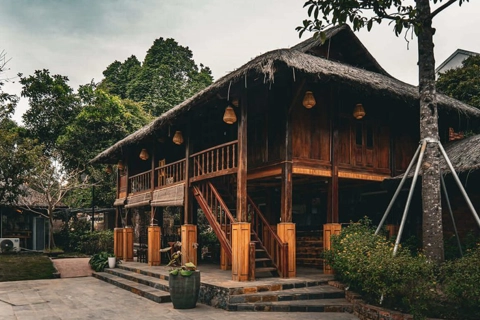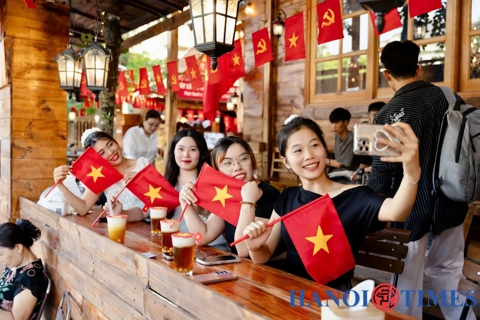Travel
A sophisticated cuisine, simply served
Feb 27, 2015 / 04:32 PM
The former royal city of Hue in the central province of Thua Thien - Hue is noted for its rich cultural traditions, serene landscape and charming people, but few people outside Viet Nam are aware of its distinctive cuisine, considered by some to be one of the most sophisticated in the country.
Bun bo Hue (beef-rice vermicelli soup Hue style) is undoubtedly the most well-known local product and is served not only in the central region but also in every corner of the country. But, many other Hue dishes, like banh beo chen (steamed rice cakes in small cups) and banh bot loc nhan tom thit (shrimp and pork rice dumplings), are also regularly featured on menus that specialise in the city's highly respected cuisine.
Opened only a few weeks ago, the Bun Bo Ganh restaurant in downtown HCM City has already lured a regular clientele, especially from 11:30am to 1:30pm when staff from office buildings nearby come for lunch.
Located on a prime location on Ho Tung Mau Street in District 1, only a few minutes walk from the 68-storey Bitexco Financial Tower, the city's tallest building, the two-storey restaurant is easy to find.
When my friend and I entered the restaurant last week, we discovered an old French colonial building that had once housed nearly 50 families.
The ground floor had been partitioned into three spaces, one of which housed the restaurant's downstairs area. Upstairs, where we decided to dine, was an airy, large al fresco area covering the entire first floor, surrounded by leafy trees and potted plants.
On the walls were photos of Sai Gon and Hue in the old days, inspiring diners, both local and foreign, to learn more about the country's history and people.
The dark bamboo tables and chairs were simply designed, which added to the cosy, comfortable atmosphere.
Nguyen Vu Quynh Anh, 29, the restaurant's owner, told me that she and her husband have a great passion for food and hospitality.
From 2002 to 2006, when they were students, they worked at the famous Nha Hang Ngon (Delicious Restaurant) and learned a great deal about gastronomy and customer services.
Then in 2012, they opened their first restaurant on Ly Chinh Thang Street in District 3.
Anh, who is also the chef, said that bun bo Hue is the restaurant's main dish. Though famous as a specialty of Hue, it is popular throughout the country.
"Of course, we need to adjust the taste so that it can satisfy the taste of people in the south and north," Anh said.
Ingredients for the dish are imported from the central region to ensure authenticity.
Unlike the traditional and more famous pho soup from Ha Noi, bun bo Hue is more pungent, with lemongrass and a bit of shrimp paste.
My foreign friends, especially Westerners, dislike the smell of shrimp paste, but only a tiny amount of shrimp paste is needed to enhance the dish.
The Hue style beef vermicelli soup is served with sides like bean sprouts, shredded banana flower, chilli, line and basil.
To make the broth, cooks use pork or beef, and lemongrass is crushed and put into boiling water, which enhances the flavour and aroma.
The menu, in Vietnamese and English, includes a variety of Hue traditional cakes, each of which costs VND22,000 (US$1). To sample a variety of these small dishes, I recommend a mixed plate for only VND36,000 ($1.5).
The restaurant also offers sweet Hue soups, served either hot or cold, for only VND13,000.
For our lunch, we ordered a bowl of bun bo Hue for VND39,000 and che suong sa hat luu (agar-agar with pomegranate seeds) for VND13,000 each.
There were other sweet soups we would have loved to try, but because we were already full, we decided to save it for our next visit.
Instead, we ended on a refreshing note, with iced green tea, spiced with fresh ginger.
A staff of 15, many of whom can speak English, offered excellent customer service, which nicely complemented what was an already highly satisfying afternoon.
Opened only a few weeks ago, the Bun Bo Ganh restaurant in downtown HCM City has already lured a regular clientele, especially from 11:30am to 1:30pm when staff from office buildings nearby come for lunch.
Located on a prime location on Ho Tung Mau Street in District 1, only a few minutes walk from the 68-storey Bitexco Financial Tower, the city's tallest building, the two-storey restaurant is easy to find.

Bun Bo Ganh restaurant, which specialises in Hue cuisine, has only been open for several weeks, but has already attracted a regular clientele.
|
The ground floor had been partitioned into three spaces, one of which housed the restaurant's downstairs area. Upstairs, where we decided to dine, was an airy, large al fresco area covering the entire first floor, surrounded by leafy trees and potted plants.
On the walls were photos of Sai Gon and Hue in the old days, inspiring diners, both local and foreign, to learn more about the country's history and people.
The dark bamboo tables and chairs were simply designed, which added to the cosy, comfortable atmosphere.
Nguyen Vu Quynh Anh, 29, the restaurant's owner, told me that she and her husband have a great passion for food and hospitality.
From 2002 to 2006, when they were students, they worked at the famous Nha Hang Ngon (Delicious Restaurant) and learned a great deal about gastronomy and customer services.
Then in 2012, they opened their first restaurant on Ly Chinh Thang Street in District 3.

Bun bo Hue is served with sides like bean sprouts, shredded banana flowers, chilli, limes and basil leaves.
|
"Of course, we need to adjust the taste so that it can satisfy the taste of people in the south and north," Anh said.
Ingredients for the dish are imported from the central region to ensure authenticity.
Unlike the traditional and more famous pho soup from Ha Noi, bun bo Hue is more pungent, with lemongrass and a bit of shrimp paste.
My foreign friends, especially Westerners, dislike the smell of shrimp paste, but only a tiny amount of shrimp paste is needed to enhance the dish.
The Hue style beef vermicelli soup is served with sides like bean sprouts, shredded banana flower, chilli, line and basil.
To make the broth, cooks use pork or beef, and lemongrass is crushed and put into boiling water, which enhances the flavour and aroma.
The menu, in Vietnamese and English, includes a variety of Hue traditional cakes, each of which costs VND22,000 (US$1). To sample a variety of these small dishes, I recommend a mixed plate for only VND36,000 ($1.5).
The restaurant also offers sweet Hue soups, served either hot or cold, for only VND13,000.
For our lunch, we ordered a bowl of bun bo Hue for VND39,000 and che suong sa hat luu (agar-agar with pomegranate seeds) for VND13,000 each.
There were other sweet soups we would have loved to try, but because we were already full, we decided to save it for our next visit.
Instead, we ended on a refreshing note, with iced green tea, spiced with fresh ginger.
A staff of 15, many of whom can speak English, offered excellent customer service, which nicely complemented what was an already highly satisfying afternoon.








